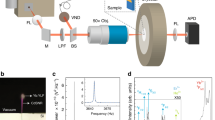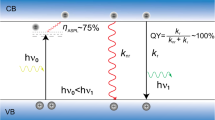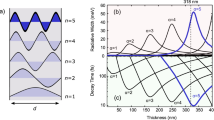Abstract
Optical irradiation accompanied by spontaneous anti-Stokes emission can lead to cooling of matter, in a phenomenon known as laser cooling, or optical refrigeration, which was proposed by Pringsheim in 19291. In gaseous matter, an extremely low temperature can be obtained in diluted atomic gases by Doppler cooling2, and laser cooling of ultradense gas has been demonstrated by collisional redistribution of radiation3. In solid-state materials, laser cooling is achieved by the annihilation of phonons, which are quanta of lattice vibrations, during anti-Stokes luminescence. Since the first experimental demonstration in glasses doped with rare-earth metals4, considerable progress has been made, particularly in ytterbium-doped glasses or crystals: recently a record was set of cooling to about 110 kelvin from the ambient temperature, surpassing the thermoelectric Peltier cooler5,6. It would be interesting to realize laser cooling in semiconductors, in which excitonic resonances dominate7,8,9, rather than in systems doped with rare-earth metals, where atomic resonances dominate. However, so far no net cooling in semiconductors has been achieved despite much experimental10,11,12 and theoretical7,8,9,13,14 work, mainly on group-III–V gallium arsenide quantum wells. Here we report a net cooling by about 40 kelvin in a semiconductor using group-II–VI cadmium sulphide nanoribbons, or nanobelts, starting from 290 kelvin. We use a pump laser with a wavelength of 514 nanometres, and obtain an estimated cooling efficiency of about 1.3 per cent and an estimated cooling power of 180 microwatts. At 100 kelvin, 532-nm pumping leads to a net cooling of about 15 kelvin with a cooling efficiency of about 2.0 per cent. We attribute the net laser cooling in cadmium sulphide nanobelts to strong coupling between excitons and longitudinal optical phonons (LOPs), which allows the resonant annihilation of multiple LOPs in luminescence up-conversion processes, high external quantum efficiency and negligible background absorption. Our findings suggest that, alternatively, group-II–VI semiconductors with strong exciton–LOP coupling could be harnessed to achieve laser cooling and open the way to optical refrigeration based on semiconductors.
This is a preview of subscription content, access via your institution
Access options
Subscribe to this journal
Receive 51 print issues and online access
$199.00 per year
only $3.90 per issue
Buy this article
- Purchase on Springer Link
- Instant access to full article PDF
Prices may be subject to local taxes which are calculated during checkout




Similar content being viewed by others
References
Pringsheim, P. Zwei Bemerkungen über den Unterschied von Lumineszenz- und Temperaturstrahlung. Z. Phys. A 57, 739–746 (1929)
Phillips, W. D. Nobel Lecture: Laser cooling and trapping of neutral atoms. Rev. Mod. Phys. 70, 721–741 (1998)
Vogl, U. & Weitz, M. Laser cooling by collisional redistribution of radiation. Nature 461, 70–73 (2009)
Epstein, R. I., Buchwald, M. I., Edwards, B. C., Gosnell, T. R. & Mungan, C. E. Observation of laser-induced fluorescent cooling of solid. Nature 377, 500–503 (1995)
Seletskiy, D. V. et al. Laser cooling of solids to cryogenic temperatures. Nature Photon. 4, 161–164 (2010)
Seletskiy, D. V. et al. Local laser cooling of Yb:YLF to 110 K. Opt. Express 19, 18229–18236 (2011)
Rivlin, L. A. & Zadernovsky, A. A. Laser cooling of semiconductors. Opt. Commun. 139, 219–222 (1997)
Rupper, G., Kwong, N. H. & Binder, R. Large excitonic enhancement of optical refrigeration in semiconductors. Phys. Rev. Lett. 97, 117401 (2006)
Sheik-Bahae, M. & Epstein, R. I. Can laser light cool semiconductors? Phys. Rev. Lett. 92, 247403 (2004)
Finkeißen, E., Potemski, M., Wyder, P., Vina, L. & Weimann, G. Cooling of a semiconductor by luminescence up-conversion. Appl. Phys. Lett. 75, 1258–1260 (1999)
Gauck, H., Gfroerer, T. H., Renn, M. J., Cornell, E. A. & Bertness, K. A. External radiative quantum efficiency of 96% from a GaAs/GaInP heterostructure. Appl. Phys. A 64, 143–147 (1997)
Imangholi, B., Hasselbeck, M. P., Sheik-Bahae, M., Epstein, R. I. & Kurtz, S. Effects of epitaxial lift-off on interface recombination and laser cooling in GaInP/GaAs heterostructures. Appl. Phys. Lett. 86, 081104 (2005)
Rupper, G., Kwong, N. H. & Binder, R. Optical refrigeration of GaAs: theoretical study. Phys. Rev. B 76, 245203 (2007)
Khurgin, J. B. Surface plasmon-assisted laser cooling of solids. Phys. Rev. Lett. 98, 177401 (2007)
Nemova, G. & Kashyap, R. Laser cooling of solids. Rep. Prog. Phys. 73, 086501 (2010)
Epstein, R. I. & Sheik-Bahae, M. Optical Refrigeration (Wiley-VCH, 2009)
Sheik-Bahae, M. & Epstein, R. I. Optical refrigeration. Nature Photon. 1, 693–699 (2007)
Eshlaghi, S., Worthoff, W., Wieck, A. D. & Suter, D. Luminescence upconversion in GaAs quantum wells. Phys. Rev. B 77, 245317 (2008)
Sheik-Bahae, M. & Epstein, R. I. Laser cooling of solids. Laser Photon. Rev. 3, 67–84 (2009)
Khurgin, J. B. Band gap engineering for laser cooling of semiconductors. J. Appl. Phys. 100, 113116 (2006)
Khurgin, J. B. Role of bandtail states in laser cooling of semiconductors. Phys. Rev. B 77, 235206 (2008)
Merlin, R. et al. Multiphonon processes in YbS. Phys. Rev. B 17, 4951–4958 (1978)
Zhang, Q. et al. Exciton-phonon coupling in individual ZnTe nanorods studied by resonant Raman spectroscopy. Phys. Rev. B 85, 085148 (2012)
Li, D. H., Zhang, J., Zhang, Q. & Xiong, Q. H. Electric field-dependent photoconductivity in CdS nanowires and nanobelts: exciton ionization, Franz-Keldysh and Stark effects. Nano Lett. 12, 2993–2999 (2012)
Basu, P. K. Theory of Optical Processes in Semiconductors: Bulk and Microstructures 209–210 (Oxford Univ. Press, 2003)
Sadao, A., Peter, C., Safa, K. & Arthur, W. Properties of Semiconductor Alloys: Group-IV, III–V and II–VI Semiconductors 103 (Wiley, 2009)
Huppert, D., Evenor, M. & Shapira, Y. Measurements of surface recombination velocity on CdS surfaces and Au interfaces. J. Vac. Sci. Technol. A 2, 532–533 (1984)
Imangholi, B. Investigation of Laser Cooling in Semiconductors 46–49. PhD thesis, Univ. New Mexico. (2006)
Xu, X. et al. Dynamics of bound exciton complexes in CdS nanobelts. ACS Nano 5, 3660–3669 (2011)
Acknowledgements
We thank M. Sheik-Bahae and R. Merlin for helpful discussions. Q.X. acknowledges the support from the Singapore National Research Foundation through a fellowship grant (NRF-RF2009-06). This work was also supported in part by the Singapore Ministry of Education via a Tier 2 grant (MOE2011-T2-2-051) and start-up grant support (M58113004) from Nanyang Technological University.
Author information
Authors and Affiliations
Contributions
J.Z., D.L. and Q.X. had the idea for this work; J.Z., D.L. and Q.X. designed the experiments; J.Z. and D.L. performed the experiments; R.C. patterned the substrates; and J.Z., D.L. and Q.X. analysed the data and wrote the manuscript.
Corresponding author
Ethics declarations
Competing interests
The authors declare no competing financial interests.
Supplementary information
Supplementary Information
This file contains Supplementary Text and Data comprising: Section 1- Electrical and Optoelectronic Properties of CdS Nanobelts; Section 2- Optical Properties of CdS Nanobelts; Section 3- Laser Cooling of CdS Semiconductor Nanobelts and Section 4-Estimation of the Luminescence Extraction or Escape Efficiency ηe. It also includes Supplementary Figures 1-9 and Supplementary References. (PDF 1718 kb)
Rights and permissions
About this article
Cite this article
Zhang, J., Li, D., Chen, R. et al. Laser cooling of a semiconductor by 40 kelvin. Nature 493, 504–508 (2013). https://doi.org/10.1038/nature11721
Received:
Accepted:
Published:
Issue Date:
DOI: https://doi.org/10.1038/nature11721
This article is cited by
-
Microstructure and Raman Scattering of CdS Films Obtained by Chemical Deposition
Journal of Applied Spectroscopy (2024)
-
Phonon-assisted upconversion in twisted two-dimensional semiconductors
Light: Science & Applications (2023)
-
Effects of Temperature on Optical Aberrations in Beam Delivery Components
International Journal of Precision Engineering and Manufacturing (2023)
-
Characteristics investigation of Yb3+:YAG crystals for optical refrigeration
Frontiers of Physics (2023)
-
Electron-phonon interactions in halide perovskites
NPG Asia Materials (2022)
Comments
By submitting a comment you agree to abide by our Terms and Community Guidelines. If you find something abusive or that does not comply with our terms or guidelines please flag it as inappropriate.



